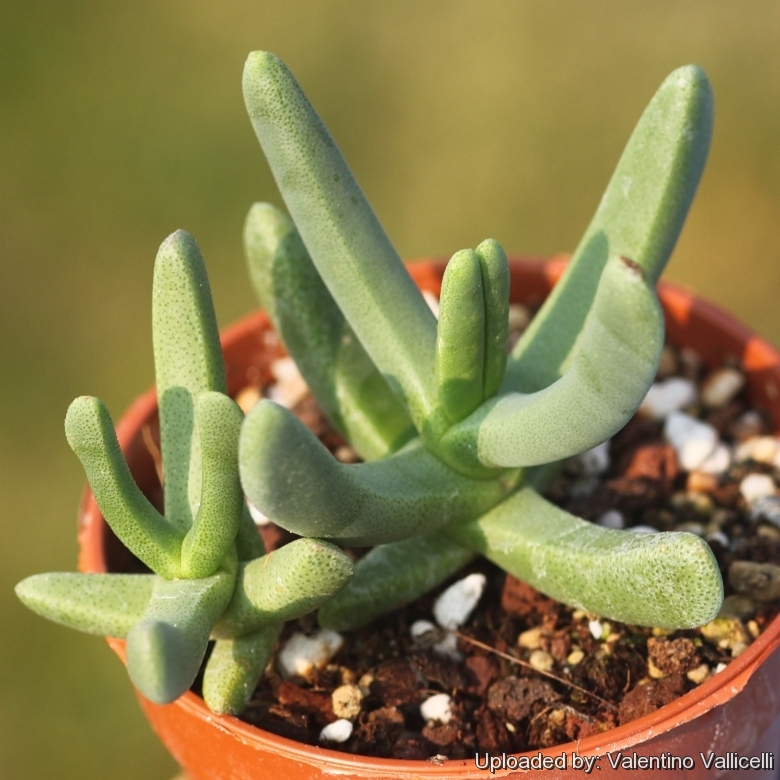




Your support is critical to our success.

Origin and Habitat: Calvinia or Ceres (?), Western Cape, South-Africa.
Altitude range: 300-650 metres above sea level.
Habitat and Ecology: Hereroa teretifoliaSN|32143]]SN|32143]] is found in the succulent Karoo, in open terrain bearing small trees and shrubs. Associated species include Crassula deltoidea, Antegibbaeum fissoidesSN|14762]]SN|14762]], Anacampseros lanceolataSN|27538]]SN|27538]], Pectinaria articulata, Pelargonium karooicum, Drosanthemum delicatulum, Adromischus triflorusSN|29812]]SN|29812]] and Glottiphyllum depressumSN|22725]]SN|22725]] plus several other. Rainfall is during winter and summer (peaks in March and November) and ranges between 75 and 150 mm per annum but with a tendency to summer dryness.
Synonyms:
- Hereroa teretifolia L. Bolus
Description: Hereroa teretifoliaSN|32143]]SN|32143]] is a compact perennial-succulent forming green upright pyramidal tuft branching from the base.
Stems: Branches up to 10, basally up to 10 mm in diameter. Upper part of stems with protruding internodes to 15 mm long.
Leaves: In opposite pairs, all pairs growing at right angles to the next adjacent, usually with 2 to 3 pairs to a branch, dull, green, terete in the middle, then pointed, a little compressed above, obtuse, green, to 5 cm long and 8 mm thick.
Flowers: Daisy-like, yellow, fragrant, 35-37 mm across. Pedicels about as long as the uppermost leaves, petals yellow, paler towards the base, reddish outside, to 15 mm long, 0.5-0.75 mm wide, filaments apically pale yellow, anthers yellow, glands distant. The numerous filamentous staminodes cast doubt on the placement of the species in Hereroa.
Bibliography: Major references and further lectures
1) Hermann Jacobsen “Handbuch der sukkulenten Pflanzen: Mesembryanthemaceae” G. Fischer, 1955
2) Heidrun E.K. Hartmann “Illustrated Handbook of Succulent Plants: Aizoaceae F-Z” Springer Science & Business Media, 2002
3) Burgoyne, P.M. 2006. Hereroa teretifolia L.Bolus. National Assessment: Red List of South African Plants version 2015.1. Accessed on 2015/12/17
4) Bradleya, Volumes 14-20 page 16, The Society, 1996
5) posa.sanbi.org/specieslist. Download from POSA (http://posa.sanbi.org) on December 17, 2015.
Cultivation and Propagation: Hereroa is a genus that require little maintenance. In cultivation the Hereroa do very well with the spring summer growing period during which they will be watered frequently and heads for winter dormancy. If you provide the Hereroa with the right conditions, they will reward you with their unique shape, and a proliferation of blooms in spring and summer. Being small plants, a representative collection can be grown on a patio table or a shelf in the greenhouse. Inside they grow fine on windowsills, and will even bloom, if they get enough direct sunlight.
Growth Rate: Slow to Moderate.
Soil: It grows best in sandy-gritty soil and requires good drainage as it is prone to root rot. It can grows outdoor in sunny, dry, rock crevices (protection against winter wet is required) It can also be cultivated in alpine house, in poor, drained soil.
Repotting: Make sure to repot during its more active period, starting in spring.
Fertilization: Feed it once during the growing season with a fertilizer specifically formulated for cactus and succulents (poor in nitrogen), including all micro nutrients and trace elements diluted to ½ the strength recommended on the label. It thrives in poor soils and need a limited supplies of fertilizer to avoid the plants developing excess vegetation, which is easily attacked by fungal diseases.
Light: Keep cool and shaded in summer, need full sun or light shade in the other season. Outdoor they prefer full sun, with some shade in the hottest summer months. Plants in pots prefer light afternoon shade in hottest summer days.
Watering: They thrive in dry and desert regions and are able to stand extended periods of drought and require careful watering. Water minimally in summer, only when the plant starts shrivelling, water more abundantly when they are growing in the autumn and spring, but let the soil dry between soaking. If grown in a container, bottom watering by immersing the container is recommended. It must have very dry atmosphere.
Hardiness: It prefer a very bright situation and require a minimum temperature 5°C (But will take a light frost and is hardy down to -7° C for short periods if it is in dry soil). USDA zones 9A – 11.
Uses: Container, rock garden.
Pests and diseases: It is vulnerable to mealybugs and rarely scale.
Plant Uses: Border, container, edging, ground cover, pot plant, rock garden. The plants also attracts bees, butterflies and other insects.
Propagation: Seed in spring or autumn or cuttings. Take the cutting from a grown-up mother plant. Each cutting must contain one or more heads along with a fraction of root and permit to dry out a couple of days, lay it on the soil and insert the stem end partially into the soil. Try to keep the cutting somewhat upright so that the roots are able to grow downward.
| Your Actions | |
|---|---|
| Back to Hereroa index | |
| Back to Aizoaceae index | |
 |
Back to Succulents Encyclopedia index |
Privacy stantement - Terms and conditions - How to cite - About us - Feedback - Donate



